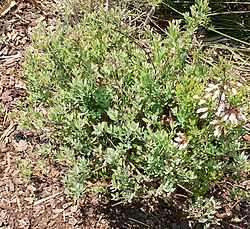Hybrid cultivars
Many commercial Southern Highbush Blueberry cultivars are hybrids, derived from crosses between Vaccinium darrowii with the Northern Highbush Blueberry ( Vaccinium corymbosum ), as well as other species such as Rabbiteye blueberry (Vaccinium virgatum) and Lowbush blueberry (Vaccinium angustifolium). [8]
Southern Highbush Cultivars, in addition to lower chilling requirements, also have greater tolerance to high summer temperatures, somewhat greater drought tolerance and develop superior fruit quality under Southern U.S. growing conditions. As a rule, Southern highbush blueberries are self-fertile. However, larger and earlier-ripening berries result if several cultivars are interplanted for cross-pollination.
The following Southern Highbush Blueberry cultivars, listed by fruit ripening time, are recommended for the fruit garden and landscape:
- Very early season: 'O'Neal'
- Early/midseason: 'Cape Fear'
- Midseason: 'Blue Ridge' and 'Georgia Gem' (adapted to the Sandhills and Coastal Plains; needs frost protection in the Piedmont)
- Mid/late season: 'Legacy' and 'Summit'
- Late season: 'Ozarkblue' (Piedmont only)


